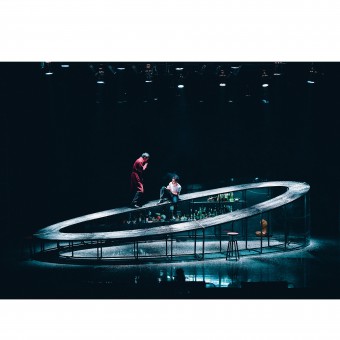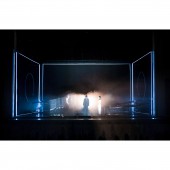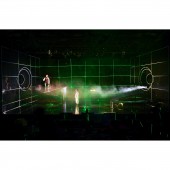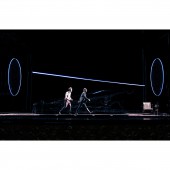
| THE AWARD |
| CATEGORIES |
| REGISTRATION |
| SUBMIT YOUR WORK |
| ENTRY INSTRUCTIONS |
| TERMS & CONDITIONS |
| PUBLICATIONS |
| DATES & FEES |
| METHODOLOGY |
| CONTACT |
| WINNERS |
| PRESS ROOM |
| GET INVOLVED |
| DESIGN PRIZE |
| DESIGN STORE |
| THE AWARD | JURY | CATEGORIES | REGISTRATION | PRESS | WINNERS | PUBLICATIONS | ENTRY INSTRUCTIONS |
Absinthe Production Design by Vivian Lu |
Home > Winners > Design #98919 >Interview |
 |
|
FS: What is the main principle, idea and inspiration behind your design?
VL: Absinthe was a project that gave me a chance to explore the potential visuals created by merging physics and scenography. This was a play that explored topics on physics, matter, and psychology. During the initial design stage, there were a lot of discussions on how to tackle such a complex play, where deep subjects were discussed, so it was important to have the set visually portray the topics in a manner that guided the audience into the discussions and immerse them into a new world. Therefore, my main aim was to experiment with different methods that enhanced audiences' senses within their theatrical experience, and find new ways to capture their imagination and make them think more deeply about their relationships with time.
FS: What has been your main focus in designing this work? Especially what did you want to achieve?
VL: With Absinthe, I tried to merge different forms of senses together (sound and sight) and to magnify them to create a lasting visceral experiences for the audience. Collaborating with the director, we tried intently to create a new form of storytelling by incorporating digital medias and different forms of art performance together as we strongly believe that immersive technologies have unearthed a power to enhance our senses in theatre.
FS: What are your future plans for this award winning design?
VL: We are hoping to bring this to further touring destination in 2021.
FS: How long did it take you to design this particular concept?
VL: It was an ongoing experimental process until we had to move our rehearsal to stage. We continued to experimental on set with the laser light until the opening of the show.
FS: Why did you design this particular concept? Was this design commissioned or did you decide to pursuit an inspiration?
VL: I was invited to design for this stage play.
FS: Is your design being produced or used by another company, or do you plan to sell or lease the production rights or do you intent to produce your work yourself?
VL: I do not intend to sell the production right.
FS: What made you design this particular type of work?
VL: As a stage designer, I am always passionate about how I can create stronger connections between audiences and my set design, and have been attempting to bring new technology and innovation in traditional theatre for the last few years of my practise. Whilst I love the traditional stage, I believe that technology is an important medium to utilise, it can transcend and elevate a stage to become more immersive, and get a wider audience to be interested and pay attention to theatre.
FS: Where there any other designs and/or designers that helped the influence the design of your work?
VL: No
FS: Who is the target customer for his design?
VL: Anyone
FS: What sets this design apart from other similar or resembling concepts?
VL: None
FS: How did you come up with the name for this design? What does it mean?
VL: It was the name of the stage play
FS: Which design tools did you use when you were working on this project?
VL: AutoCAD, modelling, sketching
FS: What is the most unique aspect of your design?
VL: The beauty of this set design is the limitless interpretation of the stage according to an audience's understanding of the play. The oval stage represents time, but can be seen as the milky way, Möbius band etc by different audiences. Through my various initial experimentation, I decided to introduce the technology of laser light sound visualizer to the set to allow the audiences' senses to be magnified within the whole theatrical experience, and allowing sound to be "seen". Through the sound vibrations created from the actors delivering their lines, laser lights were distorted based on the frequency of spoken sound. The visuals created from the actors and actress voice varied drastically according to the pitch of their voice. To perfect the visual imagery showcased on stage, actors rehearsed for months with the custom made devices to create specific visuals to go with the set design.
FS: Who did you collaborate with for this design? Did you work with people with technical / specialized skills?
VL: I collaborated with the director and eventually came up with this concept.
FS: What is the role of technology in this particular design?
VL: Technology acted as a medium to help us visually see sound and to enhance our other senses in the theatre.
FS: Is your design influenced by data or analytical research in any way? What kind of research did you conduct for making this design?
VL: This project required a lot of research and experimentation, especially experimenting with the laser light sound visualizer, making sure the visuals created from different sound frequencies went hand in hand with the general set design. A lot of prior research also had to be done on the subject matter or physics, black holes and relativity, to create a stage that portrayed elements of these subjects, and allow audiences to quickly connect and be immersed into the show that discussed complex subjects. For the staging and material we chose dark reflective panels to create the effect of this vast yet mysterious universe, and covered it with splattered paint to symbolise the milky galaxy, creating a beautiful looking stage.
FS: What are some of the challenges you faced during the design/realization of your concept?
VL: On a technical side, the production had to overcome a lot of technical difficulties; the curvature of the main stage oval shape had to be exact as they had during set changes, they were separated to create different scenes. The wheels were proved to be a technical challenge as the points of attaching the wheels made a huge difference on the stage's mobility. A lot of consideration was placed on the feasibility of how the actors moved on set. We experimented with different inclinations of the set and before the performance, we trained actors to walk, run and jump at different angles on the circular stage to avoid accidents. The whole stage was built overcoming technical difficulties and required a lot of precision, and we had to find the balance of achieving the desired artistic visual but ensure the structural safety of the stage.
FS: How did you decide to submit your design to an international design competition?
VL: I wanted to showcase this project to a wider audience group even when its not on tour.
FS: What did you learn or how did you improve yourself during the designing of this work?
VL: This was the first time where I explored different fields of subject ie. Physics into my set design
FS: Any other things you would like to cover that have not been covered in these questions?
VL: Check out more of my work on Instagram : vlu.designs
FS: Thank you for providing us with this opportunity to interview you.
A' Design Award and Competitions grants rights to press members and bloggers to use parts of this interview. This interview is provided as it is; DesignPRWire and A' Design Award and Competitions cannot be held responsible for the answers given by participating designers.
| SOCIAL |
| + Add to Likes / Favorites | Send to My Email | Comment | View Press-Release |





